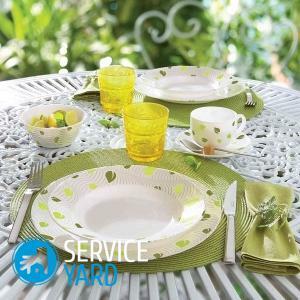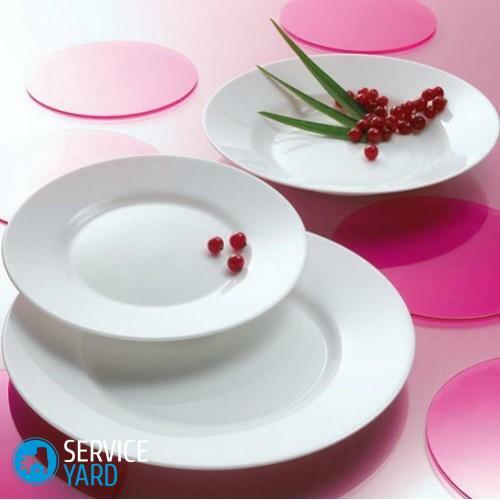
- Useful pair - soda + mustard
- Vinegar for absolute radiance
- We prepare a dishwashing detergent at home
- Popular household chemicals - is it safe?
- Grandma's Washing Techniques
Nobody in the world can say that he does not need to wash his dishes every day after eating. The detergents we use are not always safe for our health. Therefore, the question of what safe means for washing utensils in general exist and whether it is possible to make such a remedy at home is sometimes very serious. If you came to this situation or are still in the process of thinking whether to give up such comfortable household chemicals, you will find a solution after reading this article.
to content ↑Useful pair - soda + mustard
Baking soda is the most popular cleaning agent for plaque on various dishes and cutlery. Soda has a fine crystalline structure and has a mild abrasive property, cleans to shine, and also squeaks.
You can use baking soda in two ways:
- Dissolve the powder in water, wash the dishes in it, if necessary - soak the dishes in it beforehand.
- Put the soda on the dishwashing sponge and wipe off any dirt. After handling the soda ware, thoroughly rinse it and dry it dry.
Important! Soda is a safe dishwashing detergent that perfectly copes with grease and any other contaminants. But to clean dishes containing non-stick coating, it can not be used.
If your house is not found baking soda, then it may be replaced by mustard powder, since they have similar properties. Use the powder in the same way as soda: in solution or directly when applied to a sponge.
 It should be noted that mustard is slightly more expensive than soda, but crystal shine and fat removal are provided to you.
It should be noted that mustard is slightly more expensive than soda, but crystal shine and fat removal are provided to you.
Vinegar for absolute radiance
Table vinegar is another inhabitant of any kitchen. He is always ready to help in the fight against dishwashing.
Important! Do not use it for daily washing of plates, as well as cutlery. But vinegar is the best safe dishwashing detergent, if it is necessary to restore the old radiance to glass cutlery, to rid them of boring plaque or to disinfect them.
You can prepare vinegar water using the following proportions:
- 1 teaspoon of warm water;
- 50-200 milliliters of table vinegar.
Important! The amount of vinegar depends on your goal: to give the glass shine is enough and 50 milliliters, and for disinfection you need to take more.
In order to add radiance to the instruments, rinse the clear glass objects in the acetic water.
to the table of contents ↑Preparing a dishwashing detergent at home
If you want to wash dishes with a gel or liquid habitual for everyone, and do not soap the sponge with soap and sprinkle it with soda, you can prepare your own safe dishwashing detergent.
Important! This gel will be effective enough and not too expensive. It can be stored for a long time, which is why it will not need to be re-cooked every time before washing.
Composition
You will need these components:
- water - 0.5 liters;
- laundry soap 72% - ⅛ piece;
- liquid glycerin - 5 teaspoons;
- calendula alcohol tincture - 1 tablespoon;
- medical alcohol - 4 tablespoons.
- bottle with dispenser - for storing and using a ready-made safe dishwashing detergent.
Preparation:
- Chop the laundry soap with a grater or use a sharp knife.
- Transfer the resulting chips to a saucepan.
- Place a saucepan on the water bath with soap and water.
- Gradually pour water to it. A homogeneous mass must be obtained.
- Add the rest of the ingredients from our list.
- Mix thoroughly and pour the resulting mixture into a bottle.
- Allow to cool.
Safe dishwashing liquid is ready for use!
to the contents ↑Popular household chemicals - is it safe?
If, in spite of all the assurances of harm, you can not refuse household chemistry, we suggest you familiarize yourself with the rating of the most popular dish washing aids.
"Fairy" and "Myth" from Procter &Gamble
The washing products of the international concern Procter &Gamble, namely such as "Myth" and "Fairy".
Manufacturers sell them with a variety of odors. For example: with the smell of lemon, berries, orange, apple. In a wide range of dishwashing detergents, one can find one where phyllquinone E is added - a substance from chamomile, in order to protect the hands.

"Pril" from Henkel
Henkel produces detergents "Pril" and "Pemolux".The higher demand is for "Pril".
"Pril" is a dermatologically tested safe dishwashing detergent with neutral pH.It is effective enough to fight fouling in the form of fat, does not have any dyes in the composition. It does not irritate or dry the skin of the hands. Has a good cover for the dosage of the product. In the composition there is a link Xerophyte-faith, which does not violate the protective layer of the skin.
Important! The advantage of this detergent is that it is cheap, and the effect of it, as an expensive means.
Dosia by Reckitt Benckiser
Reckitt Benckiser is a world-famous company that sells home products in more than 60 countries. At the choice of consumers, a dishwashing detergent "Dosia" is also offered.
Composition of this product:
- surfactants, mineral salts, alkali - for better control of contaminants.
- Dyes - for the right color.
- Complexing agents for water softening.
- Sodium laureth sulfate - to form a foam.
Important! To protect your hands from undesirable effects, glycerine, natural plant extracts, xerophyte-faith are added to the detergent.
Detergent for dishes "Morning Fresh"
A lot of positive reviews received a detergent for dishes "Morning Fresh".
Composition: water, perfume, 15-30% anionic surfactants, dyes and preservatives. Good foam, and also protects hands.
Detergent for dishes "Lazurite" from TM "Aist"
"Lazurite" - dishwashing detergent made of:
- faience;
- crystal;
- of porcelain;
- glass;
- ceramics;
- plastics.
Important! This remedy for ТМ "Aist" is produced according to technical specification, which was developed in 2002.The newest development, according to the manufacturer, allows you to wash even the deep-fryer and protect your hands. The product is specially designed for sensitive skin:
- phylloquinone F - softens the skin and heals microcracks;
- substance xerophyte - does not allow to lose moisture.
Conclusion
Of course, natural in such dishwashing liquid is not enough. But all harmful surfactants, fragrances, dyes and other ingredients are present in acceptable proportions. Therefore, in principle, they can be considered relatively safe means for washing dishes.
Important! If you still decide to use any of the suggested dishwashing detergents from this rating, try to wash each kitchen item better after cleaning with running water. So you reduce the risk of allergic reactions and harmful chemical compounds getting into your body.
to the table of contents ↑Grandmother's dish washing techniques
For those who decided to give preference to the means provided to us by nature itself, we offer an additional list of possible options.
Wood ash and sand
The first means for washing dishes and pots were handy tools - sand and ash. Those who have at least once rested in nature without taking detergents with them or went on a campaign know that it is wood ash and sand that perfectly wash the most greasy and sooty cauldrons or barbecues. This method of washing dishes is quite good, but not suitable for daily cleaning, because you will not be the same as pulling home the mountains of sand.
Grated potatoes
Thoroughly clean the dishes with a narrow neck, for example a vase, will help grating potatoes. A potato cut in half will help clean the burnt pan.
Freezing
Frying pan covered with grease can be easily cleaned without using water if placed in a freezer for 30 minutes. After such a procedure, the fat will simply be removed with paper towels or with napkins, leaving the slightest trace.
Now you have an idea of what kind of safe means you can use to wash dishes. We hope that we helped you make the right choice.



